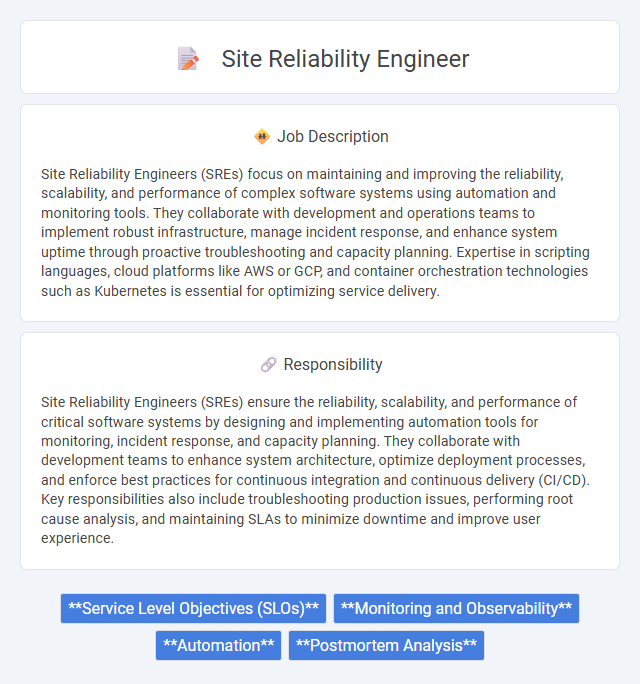
Site Reliability Engineers (SREs) focus on maintaining and improving the reliability, scalability, and performance of complex software systems using automation and monitoring tools. They collaborate with development and operations teams to implement robust infrastructure, manage incident response, and enhance system uptime through proactive troubleshooting and capacity planning. Expertise in scripting languages, cloud platforms like AWS or GCP, and container orchestration technologies such as Kubernetes is essential for optimizing service delivery.
Individuals who thrive in high-pressure environments with strong problem-solving skills and a passion for system stability probably find Site Reliability Engineering (SRE) suitable. Those who enjoy continuous learning, automation, and effectively managing complex infrastructures are likely to excel in this role. Conversely, people who prefer routine tasks without frequent interruptions or high accountability might struggle to adapt to the dynamic demands of an SRE position.
Qualification
Site Reliability Engineer roles demand expertise in software development, systems engineering, and network infrastructure. Key qualifications include proficiency in Linux/Unix operating systems, experience with cloud platforms like AWS or Azure, and strong coding skills in languages such as Python, Go, or Java. Candidates must also demonstrate knowledge of automation tools, monitoring systems, and incident response to ensure high availability and reliability of production environments.
Responsibility
Site Reliability Engineers (SREs) ensure the reliability, scalability, and performance of critical software systems by designing and implementing automation tools for monitoring, incident response, and capacity planning. They collaborate with development teams to enhance system architecture, optimize deployment processes, and enforce best practices for continuous integration and continuous delivery (CI/CD). Key responsibilities also include troubleshooting production issues, performing root cause analysis, and maintaining SLAs to minimize downtime and improve user experience.
Benefit
A Site Reliability Engineer role likely offers significant benefits such as competitive salaries, opportunities for skill development, and involvement in cutting-edge technology projects. The position may also provide enhanced job stability by ensuring system reliability and uptime, which are critical for business operations. Candidates could expect a collaborative work environment that promotes problem-solving and continuous improvement.
Challenge
Site reliability engineers likely face constant challenges in balancing system reliability with rapid deployment of new features, requiring meticulous problem-solving skills. They probably encounter unpredictable incidents that demand quick diagnosis and mitigation to minimize downtime. Managing complex infrastructure and scaling systems under pressure is expected to be a continuous source of professional challenge.
Career Advancement
Site reliability engineers (SREs) leverage expertise in software engineering and IT operations to enhance system reliability, scalability, and performance. Career advancement often involves progressing to senior SRE roles, lead engineer positions, or moving into engineering management or DevOps leadership. Developing skills in automation, cloud infrastructure, and incident response analytics significantly boosts promotion opportunities and salary growth.
Key Terms
Service Level Objectives (SLOs)
Site Reliability Engineers (SREs) design and monitor Service Level Objectives (SLOs) to ensure system reliability and performance meet user expectations. SLOs define measurable targets for availability, latency, and error rates crucial for balancing innovation speed with operational stability. Continuous analysis of SLO metrics allows SREs to prioritize incident response and optimize infrastructure, reducing downtime and improving customer satisfaction.
Monitoring and Observability
Site Reliability Engineers (SREs) specialize in Monitoring and Observability to ensure system reliability and performance by implementing advanced metrics tracking, distributed tracing, and log aggregation. They leverage tools like Prometheus, Grafana, and Elasticsearch to collect, visualize, and analyze real-time data, enabling proactive incident detection and rapid troubleshooting. Effective observability practices improve uptime and reduce mean time to resolution (MTTR), directly enhancing user experience and system stability.
Automation
Site reliability engineers specialize in automation to enhance system performance and reduce manual intervention by deploying scalable scripts and tools. They design automated monitoring, alerting, and incident response systems to maintain high availability and reliability of services. Continuous integration and continuous deployment (CI/CD) pipelines are streamlined through automation to accelerate software delivery and minimize downtime.
Postmortem Analysis
Site reliability engineers (SREs) conduct comprehensive postmortem analysis to identify root causes of system failures and outages, ensuring transparency and continuous improvement. Detailed documentation of incident timelines, impact assessments, and corrective actions facilitates learning and prevents recurrence. This systematic approach enhances overall system reliability and contributes to robust infrastructure management.
 kuljobs.com
kuljobs.com